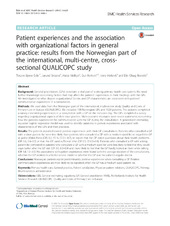| dc.contributor.author | Straand, Jørund | en_US |
| dc.contributor.author | Melbye, Hasse | en_US |
| dc.contributor.author | Rortveit, Guri | en_US |
| dc.contributor.author | Hetlevik, Irene | en_US |
| dc.contributor.author | Eide, Torunn Bjerve | en_US |
| dc.contributor.author | Rosvold, Elin Olaug | en_US |
| dc.date.accessioned | 2016-10-05T06:44:01Z | |
| dc.date.available | 2016-10-05T06:44:01Z | |
| dc.date.issued | 2016-08-24 | |
| dc.Published | BMC Health Services Research 2016, 16(1):428 | eng |
| dc.identifier.uri | https://hdl.handle.net/1956/12917 | |
| dc.description.abstract | Background: General practitioners (GPs) constitute a vital part of a strong primary health care system. We need further knowledge concerning factors that may affect the patients’ experiences in their meetings with the GPs. We investigated to what degree organizational factors and GP characteristics are associated with patients’ communicative experiences in a consultation. Methods: We used data from the Norwegian part of the international, multi-center study Quality and Costs of Primary Care in Europe (QUALICOPC). We included 198 Norwegian GPs and 1529 patients. The patients completed a survey concerning experiences in a consultation with a GP on the inclusion day. The GPs completed a survey regarding organizational aspects of their own practice. Main outcome measures were seven statements concerning how the patients experienced the communication with the GP during the consultation. A generalized estimating equation logistic regression model was used to identify variations in patient experiences associated with characteristics of the GPs and their practices. Results: The patients reported overall positive experiences with their GP consultations. Patients who consulted a GP with a short patient list were less likely than patients who consulted a GP with a medium sized list to regard the GP as polite (Odds Ratio (OR) 0.2; 95 % CI 0.1–0.7), to report that the GP asked questions about their health problems (OR 0.6; 0.4–1.0) or that the GP used sufficient time (OR 0.5; CI 0.3–0.9). Patients who consulted a GP with a long patient list compared to patients who consulted a GP with a medium sized list were less likely to feel that they could cope better after the GP visit (OR 0.5; 0.3–0.9) and more likely to feel that the GP hardly looked at them while talking (OR 1.8; 1.0–3.0). No associations with patient experiences were found with the average duration of the consultations, whether the GP worked in a fee-for-service model or whether the GP was the patient’s regular doctor. Conclusions: Norwegian patients report predominantly positive experiences when consulting a GP. Positive communication experiences are most likely to be reported when the GP has a medium sized patient list. | en_US |
| dc.language.iso | eng | eng |
| dc.publisher | BioMed Central | eng |
| dc.rights | Attribution CC BY | eng |
| dc.rights.uri | https://creativecommons.org/licenses/by/4.0/ | eng |
| dc.subject | Primary health care | eng |
| dc.subject | General practice | eng |
| dc.subject | Patient satisfaction | eng |
| dc.subject | Physician-patient relations | eng |
| dc.subject | QUALICOPC | eng |
| dc.subject | Norway | eng |
| dc.subject | Health-services administration | eng |
| dc.title | Patient experiences and the association with organizational factors in general practice: results from the Norwegian part of the international, multi-centre, cross-sectional QUALICOPC study | en_US |
| dc.type | Peer reviewed | |
| dc.type | Journal article | |
| dc.date.updated | 2016-08-24T06:03:06Z | |
| dc.description.version | publishedVersion | en_US |
| dc.rights.holder | The Author(s). | |
| dc.identifier.doi | https://doi.org/10.1186/s12913-016-1684-z | |

